Problem Statement
Introduction
This dissertation critically illustrates the perceptions of the ‘Youth Antisocial behavior’, connecting with the victims’ response and the factors touching the citizens’ motivation and exploration within the existing exercise of the legislative programs that have emerged, and been experienced in the jurisdiction of England and Wales, through long practice. The government is under pressure to implement the white paper, bill, and regulations issued by the British legislative program up to 2012. However, there is no evidence to establish any sustainable standard of adopting the fair and responsible legal and regulatory approach to youth antisocial behavior in Britain, which is acceptable to society. To examine and explore these issues, this dissertation contains six major chapters. The problem statement explores the background problem of the research, and the literature review presents the theoretical framework for the research. This study will identify an appropriate methodology that describes the method of collecting primary data to scrutinize the extent of youth antisocial behavior. In addition, the findings and discussion chapter will present the analysis of the data and assist to draw conclusions and recommendations, respectively.
Background of the problem
Prior and Paris (2005, p.4) mentioned that the criminal justice system of England and Wales believes that children below ten years are ‘incapable’ of committing crimes. It is not possible to levy criminal offense charges against children (below 10 years of age) who commit crimes. Even though the intensity of crimes committed by children below the age of 10 years may be the same as that of the crimes committed by adults, the sanctions for the children below 10 years of age are different from those for adults.
Ward & Woodhouse (2012, p. 4) pointed out that the Criminal Justice and Police Act–2001 allocated power to the local administration to impose restrictions on alcohol-related behavioral disorders in public places, and urged that it may not be an offense to drink alcohol in the designated area, but police have been empowered to control the use of alcohol in such places. The government published a white paper through the Home Office with the aim to provide more efficient rejoin to the anti-social behavior putting the highest emphasis on the victims. In order to make the process more efficient, six new powers came into being, in place of the nineteen active powers, in order to diminish antisocial behavior (Home Office 2003, p.3).
Strickland (2012, p.12) engaged his efforts to identify the impact of anti-social behavior by indicating a number of dreadful illustrations in recent cases of individuals, where the actors had destroyed their lives or resulted from serious casualty to the victims of anti-social behavior that drew increasing attention of the legislators to adopt appropriate legislative measure to protect youth anti-social behavior. In 2007, the case of Fiona Pilkington demonstrated that the woman killed her disabled daughter due to the youth’s antisocial behavior and later committed suicide. The jury held the Leicestershire Police and two local councils responsible for the ‘unlawful’ killing and suicide (Watson 2012). Such incidents generated increasing pressure on the local MPs to organize legislative measures to control antisocial behavior of the youth, the development of the public’s perceptions regarding anti-social behavior has taken a wide range of concurrent legislative debate in the local areas, and citizens are worried and even angered with such behavior of the youth (Strickland 2012, p.3).
Mahoney, Stattin & Lord (2004, p. 9) stated that the unethical performance of the antisocial youth and the hidden terms of legislative programs become more complex when the increasing number of victims in England and Wales make the society unstable and sometimes, drive the victims to commit suicide. There have been instances where the victims of youth antisocial behavior have expressed their intention of committing suicide. In a particular incident, not being able to bear the unethical behavior of the antisocial youth, the victim killed her daughter and later committed suicide. Thus, it is essential to study the youth antisocial behaviors and the concerned response of the victims for proper implementation of sustainable legislative programs in Britain (McGuire 2011).
Rationale of the research
Many scholars tried to find out the solution to the following questions:
- What is the reason for youth antisocial behavior in the UK?
- How are the youth antisocial behaviors influencing victims’ lives?
- How appropriate are the legislative programs that could develop the situation by increasing victims’ confidence?
The UK is at the top of all European countries for its high rate of youth crime and highest number of adolescence in custody. The legal framework of Britain settled the age of ten as the minimum level to impose criminal liability within their territory (WYS: Facts and Stats: Youth crime in England and Wales 2011). During 2007-2008, the number of criminal offenses committed by the youth under eighteen was very high, but the judicial system considered only 277,986 cases; however, this resulted in a decrease of 21.6% in youth antisocial behavior during the next year. The cost per juvenile offender was £34,000 and that for the special justice system for the youth was £4 billion (WYS: Facts and Stats: Youth crime in England and Wales 2011). There are different analyses regarding the cause of increasing youth antisocial behavior, some of the studies identify poverty and social disadvantage as major causes, others pointed to unemployment, family violence drug and alcohol use are the different catalysts that increase the youth antisocial behavior in the UK society. The most dangerous scenario of the UK society is that the young people caught and endorsed to resolve antisocial behavior under the criminal justice system may not rectify them, but commit similar offenses repeatedly.
The rationale of this research is to analyze the roles of the youth antisocial behavior in Britain experienced by observing the real scenario of the victims to evaluate to what extent the existing practice of youth antisocial behavior is effective in reducing the adolescent criminal offense. In addition, this research has aimed to escalate the awareness of legislators, policymakers, and regulators to take control over the hazardous attitude of the antisocial youth in Britain while the policymakers are anxious to bring back the victim’s confidence in the legislative program. Moreover, this dissertation has aimed to assist the academia, regulators, policymakers, and victims with a better understanding of the lacking of youth antisocial behavioral practice and related deceptive practice including its driving force such as unholy alliance with the law enforcement agencies, lawyers, and outsourcing agents of service providers related to youth antisocial behavior. Through this investigation and its outcomes, the legislative programs and voluntary organizations will get a potential investment environment in the human resource development of Britain and get a better level of confidence of the inventor, which will endow with the companies a practical advantage over the youth antisocial and social workers who are involved with the present unethical practice.
Research Question and Objectives
There are so may research already conducted with the nature and shape of youth antisocial behavioral standard and practice in Britain with the aim to rectify and motivate adolescence. The objective of the governmental policy is by supporting both the victims and antisocial youths with ethical standards of the legal framework of the UK that may reflect the economic and business reality for the nongovernmental organizations that are interested to assist the victims by formulating their investment decisions to providing social care.
This study scrutinizes the understanding of the emergence and development of the roles of youth antisocial behavior in Britain by adopting the political economy of the criminal procedure along with globalization approach as the base of the theoretical framework to deliver a sustainable legislative program approach to reducing the youth crime trend in the society. This dissertation aimed to investigate, do the historical perspectives of youth antisocial behavior linking with victims’ response with the watchful drive of legislative programs towards the following research questions-
- What program areas need modification and address for the antisocial behavior legislation to become effective deterrents to youth antisocial behavior in Britain?
- Have the trends for youth antisocial behavior in Britain changed, either positively or negatively, as a direct consequence of the introduction of the legislation?
- What is the role of the community in ensuring that such legislation aimed at curbing youth antisocial behavior becomes effective?
Relevant Literature Review
UK Legislations for Youth Antisocial behavior
Bell & Jones (2002) presented the chronological map of the UK youth policies and its gradual development during the first term of the Labour government from 1997-2001 while the home office had always kept its highest efforts to generate a new scheme to reducing youth crime and published several proposals to restructuring the youth justice system for England and Wales. The Crime and Disorder Act- 1998 put an end to the common law supposition that children under 14 are not able to differentiate between right and wrong, so the court has empowered to set up a process of reparation for the young offenders to attend training sessions to rectify the behavior of young criminal offenders (Burney 2005). ASBOs1 came into existence by Section 19 of Anti-social behavior order Act-1999, as a civil precautionary order. According to it, the court can frame charges against any person (16 years or less), who is performing a criminal action that distresses any other person or community. ASBO framed its first charge in mid-1999 as a civil proceeding instead of criminal sanctions (Burney 2005). Under the same legislative framework, Child Curfew Order and Child Safety Order were introduced in order to interpret the premature involvement of offense by children (under 10), without imposing criminal liability. Anyone who breaks Curfew Order faces the risk of going on a social work control scheme according to the decision of LA and police (Bell & Jones 2002).
Under this legislation, it became the duty of the local authorities, police, and social workers to supervise children below 10 on the streets at night and to ensure education, training, and social services to rehabilitate them in the mainstream of that locality by providing different state facilities (Bell & Jones 2002). The chronological development of the children policy of the UK government has developed through the quick-shifting nature of legislative framework that further evidenced the Criminal Justice Act 1982 that abolished the provision of imprisonment for the people under 21 and reduced the application of the custody for young offenders at the YCCs2. Now it lasts for no longer than 4-6 months. In 1991, the Criminal Justice Act was amalgamated with the Children Act-1989 with the aim to coordinate punishment and welfare and changed the name of ‘Juvenile Court’ to ‘Youth Court’ by extending its jurisdiction up to 17 years by amending the definition of the young person, while the Criminal Justice and Public Order Act-1994 integrated new secure training orders (Millie 2009).
Youth Justice and Criminal Evidence Act-1999 uphold the continuous process of developing the Youth Justice system by changing the court procedures for young people and introducing YOP3 for delinquents of 10-17 years, the age limit had shifted to the range of 12-14 with the aim to accommodate them by the local authority as YOTs4 providing further scope for rectification. Moreover, Licensing (Young Persons) Act-2000 and Criminal Justice and Police Act- 2001 provided further scope for the youth offenders to reduce their antisocial behavior and to protect rebellious performance in public places by providing police enough powers to protect accredited premises without any delay to deal with antisocial behavior.
Defining Crime and Anti-Social behavior
Hayden (2011) defined crime as a performance that stands against the law while ASBA5 -2003 clarified Anti-social behavior as an assortment of extensive variety of objectionable performances such as vandalism, scribbling, threatening, fly-posting, and nuisance that hampers the usual life of neighbor or group, under the Act the local authorities, police, and landlords are highly empowered to encounter such behavior.
At the same time, OAPA6 -1861 and PHA7 -1997 simultaneously pointed anti-social behavior as the occurrence of drunk and disorderly behavior, harassment, offenses against the state, breach of public order, both civil and criminal damage that generates a background to the more serious criminal offense could be taken place as a consequence of those actions. According to the public perception, crime and anti-social behavior are synonymous that can seriously injure neighbors and ruin society and civilization, such problem behaviors have a wide variety of social and psychological explanations dealt by criminology, but the most burning demand of society is to prevent threats of likewise misconducts. From the social practice, it has been evidenced that crimes are committed with an intention to gain something, violating the existing legal framework and damaging others’ rights. However, anti-social behavior has no intention to gain. Rather, it goes for the actor’s entertainment; not knowing the consequences. The crime and antisocial behaviors of the adults are taken up for a trial, but juveniles’ delinquencies or youth antisocial behaviors are sometimes ignored due to the criminalization of the social policy; moreover, children’s behavior is largely influenced by parents, schoolteachers, and their surrounding adults. The policymakers aimed to nourish mental health and provide special education rather than punishment.
Difference between Crime and Antisocial behavior
Prior & Paris (2005) pointed out that the legal age, as per the legislative framework of England and Wales, to impose criminal liability on a person is ten years old. Thus, British Law presumes that any child under the age of ten years will not be criminally responsible. Children less than ten may not regard with a criminal offense while a person over ten would be charged with criminal liability, for instance, physical assault on an individual, robbing or stealing someone’s private property without any consent may not frame any charge of the criminal offense for the child under ten (Ross, Duckworth & Smith 2010). As the legal explanation pointed out that a person under ten is incapable to commence a crime, in this context it would not be a valid statement to point crime or criminal behavior to the children below ten, rather the criminal justice system has engaged to point such behavior as antisocial behavior and involved the legislative program to reducing such behavior.
On the other hand, Connell, Cook & Brex (2011) and Donoghue (2008) said that the criminal law urged that children over ten would be fully accountable for the same degree of criminal offenses as adults, although the court proceeding and the extent of the sanction granted to the guilty children of ten and above are not same as the adult criminals. Even though the implications of criminal actions committed by children aged 10 to 13 are the same as those committed by adults, legal assumptions do not consider them as ‘Crimes’. However, under the jurisdiction of England and Wales, the crimes committed by adolescents as well as adults are of the same severity. (Ensor, Marks & Hughes 2010). Due to the recent changes of law, the changing dynamics of the age limit for criminal responsibility has a greater impact on the increasing youth crime and growing unrest in Britain society.
Public Opinion on Antisocial behavior
Mackenzie (2010) conducted a landmark study with 200 neighbors’ observations to identify the public opinion regarding anti-social behavior; depending on the household survey, they demonstrated that the people are much more aware of drug-related antisocial behavior, which has scored at 57% based on that particular area reporting. Frick & White (2008) and Hallsworth (2010) stated that another survey illustrated antisocial behavior concerned with social housing has ranked at 59% and the respondents demonstrated their highest concern regarding the vandalism as a major dilemma of that area that was surveyed. To take appropriate preventive measures against anti-social behavior, the law enforcement agencies required exact data of such events. Presently, the data provided by the local authorities is not reliable as it has adjustments with odd ratio analysis of the residents where ASB8 took place. Moreover, local people urged that the ratio of antisocial behavior has reduced due to the legislative programs, but the information furnished from the local authorities has demonstrated mostly contrary options with people’s perception; thus, it is very important to conduct national surveys to measure the extent of antisocial behavior (Hayden 2011).
Innes & Jones (2006) conducted another milestone research and found that public perception of different areas emphasized to strengthen the safety measures against antisocial behavior by the LAs and police could be significantly different due to the co-existence of separate ethnic groups living very near to each other with similar economic and demographic features and categorized public opinion as follows –
Public Opinion on Risk Factors
The public opinion regarding the ASB is continuously rising due to the concerning risk factors that the local communities are encountering at an increasing rate. Crimes with long-lasting impact on social and environmental safety made people more aware of the conservation of their locality. Such perception would assist in harmonizing the preventive measures by police and local authorities.
Public Opinion on Resilience Factors
In a number of communities, the public opinion were capable of encountering and diminishing the associated risks and threats spread out in the society from the anti-social behavior and crime delivered by the youth actors of that society, such flexibility of the factors incorporated with the meticulous distribution of economic and social capital in that area (Flint & Nixon 2006). This type of resource allocation is deeply concerning accordance with the degree of social unity and solidarity among the people of that area, their aptitudes to the groups of that society to work together to employ comfortable social control techniques with the aim to encounter ASB challenge with collective efforts from the joint vision (Hine & Williams 2007)
Public Opinion on Recovery Factors
In some of the communities, it evidenced that public perceptions on ABS have organized to promote and propagate the real and supposed range of local safety that they put into practice through effectual policing and successfully provided an essential range of security to the local communities with dynamic strategic actions to control ASB as part of their environmental improvements
Areas that need modification
None of the local authorities would accept to have any public drunkenness at their locality, even, they do not allow viewing any scenario of harassment or fear at their doorstep, but the reality of the country consists with huge anti-social behavior and crime as a part of daily life (SSHD: Putting Victims First More Effective Responses to Anti-Social behavior 2012). Due to the continuous efforts of the central government and legislative programs, the rate of antisocial behavior has decreased remarkably, but not enabled to eliminate from the society while police have to encounter at least three million ASB events and the number of such events is increasing in every year. As a result, the extent of the antisocial behavior is rising towards a most vulnerable stage with utmost risk of the society where it is essential to modify the ASB strategy for the local communities, social property owners, and police with a harmonized strategy for all actors in this area.
The previous experience of working with antisocial behavior has generated huge experience of negative outcomes of the ASB encounters and in some contexts, the governmental model for ASB has not delivered any positive outcomes to resolute the problem, rather some irrespective measures have increased the impact of the antisocial behavior in society. Thus, the most recent modification of ASB controlling programs need the attention of the local views without imposing the solution from the outside, every local authority would then integrate their necessary ASB controlling measures, which they feel to be well fitted with the present scenario, where property owners have the greater opportunity to establish control over anti-social behavior. Under the modified program, it would be essential to empower victims and communities; allocation of more power to the local authorities to take immediate action to prevent treacherous and yobbish behaviors endangering the lives of the victims, such powers would consist of new court order available for the conviction that would assist to stop the antisocial behavior of youth.
The Impact of Youth Antisocial behavior in the UK
How ASBOs Developed
Anti-Social behavior Orders were introduced under the section 1(c) of the Crime and Disorder Act-1998 in order to impose conviction to a delinquent for applicable offense, where ASBO could be obtained through appropriate authorities (demanded by the prosecutor and granted by the court) described in the civil proceeding under section-1 of the CDA (CPS: Anti-Social behavior Orders on Conviction 2012). ASBOs9 came into execution in 1999, which has been going through different amendments with some other Acts like Police Reform Act-2002, Anti-social behavior Act-2003 along with the Serious Organised Crime and Police Act-2005, keeping all the relevant legislation into accomplishment, ASBOs come to function as civil orders to defend the behavior that generates harassment and distress to people.
Implication of Anti-Social behavior
Loeber (1990) and Rutherford (1986) explored that the frequency of antisocial along with delinquent behavior among young people has amplified noticeably during the past decades connecting with the dominance of other health risk related behaviors like the use of dangerous drugs and suicides, the concurrent trend of antisocial behavior has increased the psychiatric entrance with exceptional placement at school. It has positioned the shifting nature of delinquency reflected with decreasing rate of desire organized by the children related with antisocial as well as delinquent behaviors linked with age-specific expression, social knowledge along with biological risk factors that develop the life cycle of the antisocial behaviors at diverse points.
Sadler (2008) and Wisniewska, Harris & Oliver (2006) conducted an ethnographic study with the performance of the legislation of anti-social behavior in a housing estate of the UK including its greater impact on the existing ‘youth anti-social behavior’ program closely related with local policing to ensuring secrecy of the people and places with rising knowledge regarding the legislation. The involvement of the people among local services and growing community safety concerns have strengthened the traditions to accumulating problematic young people in public spaces of the estate and began to aggravate to delicate youth relationship with police at an optimistic level with the belief of stigmatization and socially prohibiting those youths to mixing with local youth community (Sherman & Strang 2007).
The research identified young people, previously criminalized with race and class, as the main reason for ‘anti-social behavior’ (SGC: Breach of an Anti-Social behavior Order 2008). It also identified that the burden of social controls over the young and juvenile delinquent would essentially promote the problematic behavior, for instance, engraving setting would be a constraint on the liberty of children and make them more nervous in comparison to the adults. The children are indignant or offended to control, that adults are capable to exercise.
Brogan (2005) mentioned that, although the target of the YJB10 is to decrease the number of youth in custody, due to the lack of appropriate information flow and accurate management information with the ASBOs, the targets of gaining statutory obligations have demonstrated negative outcomes that made the YJB bound to emphasis on correct information system for exact decision-making. Brogan (2005) and Card & Ward (1998) mentioned that the two main beneficiaries of data in this regard are the Home Office and the YJB, the core data generally available to organize statistical presentations that assists to assess the achievement and execution of ASB legislation, the YJB has statutory responsibility for the youth to ensure secure accommodation into the custody. Thus, the intention of data collection by the two organizations is completely different from implementing the ASBOs and the entire process has presented in the following figure-
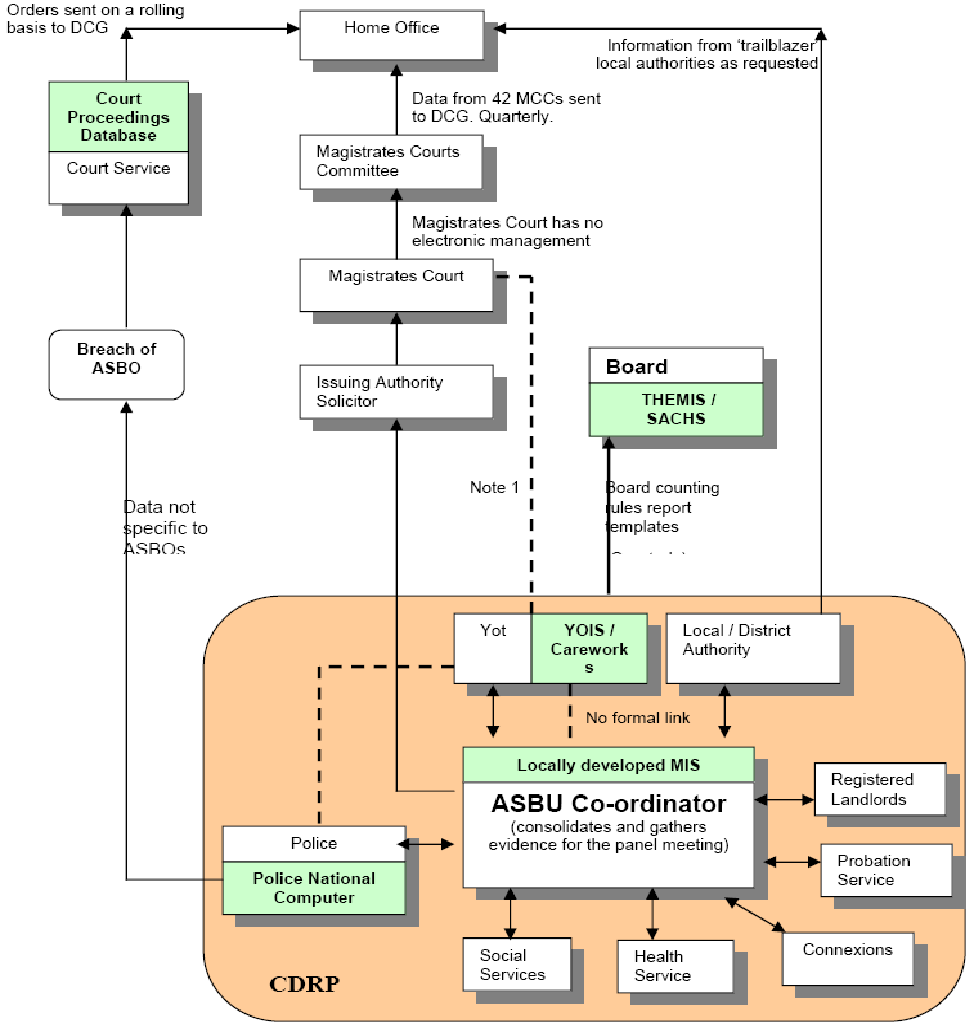
ASBOs as a Process of Criminalising Youth
Crawford (2009, p.22) critically analyzed the impact of power diffusion initiated as part of the UK government’s attempt to reduce anti-social behavior of the young people and argued that the young generation has been negatively impacted by the dispersal orders. The process considers identifying the technique by which the dispersal powers could boost antagonism between police and the youth of society, putting the special focus of the police on the youth, making young people more vulnerable while the public perception urges that at public spaces young anti-social behavior brings more risk to society rather than themselves (YJB 2005). In the modern society of the UK anti-social behavior has turned into a major political concern for the local and public management agencies due to increasing youth anti-social behavior for which all the state agencies are seriously alarming further shock due to principally vulnerable trend of the youth to be the victims of crime and anti-social behavior mapped as follows-
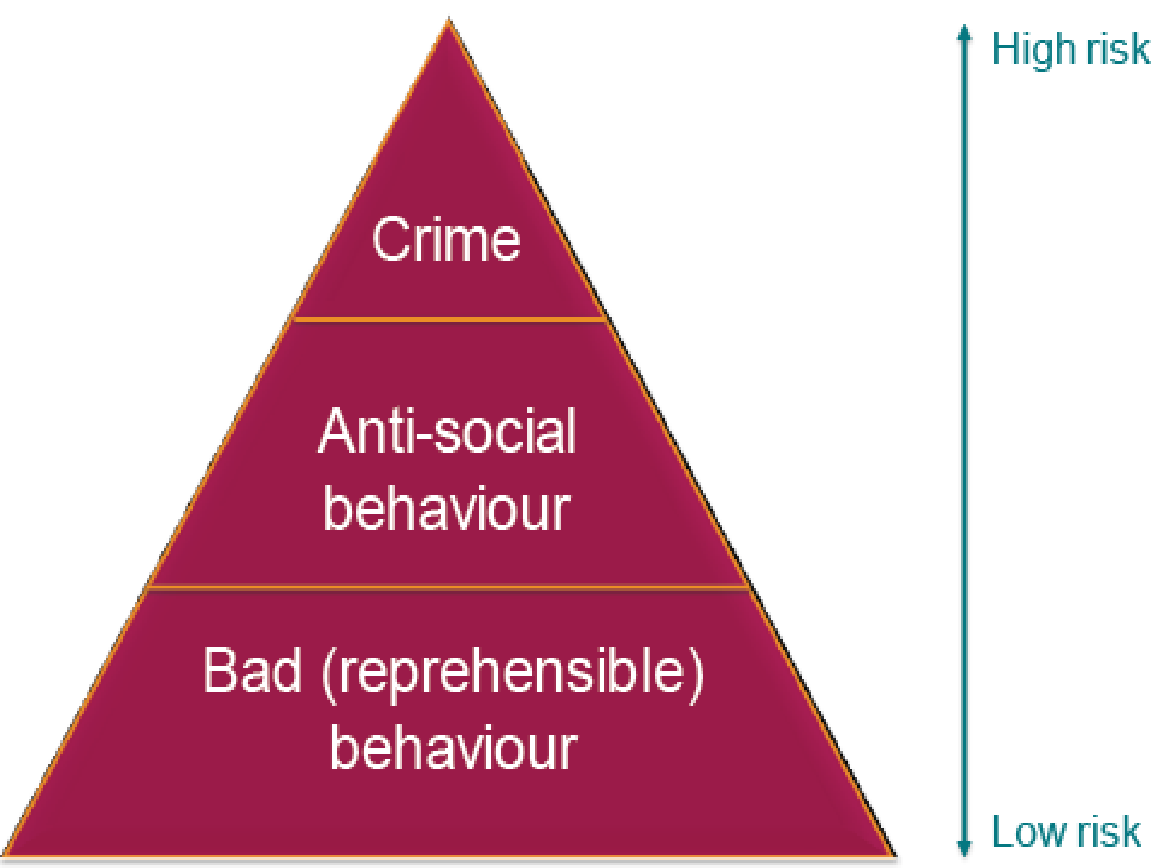
Hallsworth (2010, p.6) and Solanki, Bateman & Hill (2006) engaged his efforts to rethink the youth antisocial behavior by presenting his harms pyramid arguing that the Bad behavior is at the bottom line of the pyramid with lower risk, anti-social behavior is in the middle of the pyramid that ultimately turns into crime with higher associated risk. The UK government is under pressure to form an optimistic youth policy for the British nation, but the continuous shifts of legislation, changing viewpoints to the crime and incivility, shifts in civil and criminal procedures have dramatically re-figured the pathway obviously far away from the youth justice and the complex dynamics have been criminalizing the entire scheme (Solomon 2004).
Negative Trends of Youth ASBOs in the UK
Brown (2011) and Squires & Stephen (2005) conducted a landmark survey with the perception of the young generation of Britain regarding their ASBOs and explored depth insights at the case-level that prolong among the young people with a serious frustrating indicator to the system by the selected demography that was surveyed. The youth respondents’ data about ASBOs were very appalling; the data suggested that such youth had to go through severe punishments because they breached the orders. They considered this legislative framework as a blueprint to destroy the young generation, by rigorously restricting the regular performance and potentiality of the youth. The level of ASBOs has integrated as a modifying scheme of the lives of young people, which is generally difficult to assess while the scenario of their lives usually illustrates themselves to move towards further compliant behaviors, culpability and blameworthiness are seriously integrated among the young generation with unfairness those are resulting from ASBOs and amalgamate them with the fake allegation.
The findings of Brown (2011) raised a momentous question that pointed the theory and practice of ASBOs as a now-notorious theory, at the same time it has explored a new window to the ASBOs function to conduct further research with the secret truth beneath the youth stories of Britain for which the ASBOs feels shame and embarrassment. There are not any trouble-free policy prescriptions within the ASBOs, but on the ground of social justice, the government and legislative programs do not dare to recognize the destructive impact of youth behavior. This may not justify the coercive measures imposed by the aspiration of social policy, thus to encounter powerful policymakers, the relatively powerless youth would align with more anti-social behavior.
The Role of Communities in Reducing Youth Antisocial behavior
The Role of NGOs in Reducing Youth Antisocial behavior
NIA (2008) and Lister & Crawford (2007) mentioned that NGOs have greater participation at the implication of the ASBO in the UK, thematic clusters such as defining the child and youth, implementation of ASBOs with general principles, civil rights and freedoms, alternative care, health, education, and culture, while NGOs believe the UK government has been promoting fair policies to reducing ASB. Under Article 37 of UNCRC regulation that guided the lodgings of children in the custody where the NGOs Disagreed to unite with the government’s proclamation that Northern Ireland is the area of exception wherein the studios, children are accommodated with adults, and the NGOs are increasing their continuous pressure to uphold the UNCRC protocol (Williamson 2004). The UK government has already integrated most of the UNCRC provisions into local legislation, but regarding the implication, there are some deviations with the NGOs are increasing pressure to implement unified policy practice where the government and the NGOs come into a convention to implementing coordination formulation a permanent body (CIVITAS: Youth Crime in England and Wales 2012).
The NGOs welcomed the government proposal to establish a single platform to ensure partnership among the OFMDFM11 that established a wing in the ministry called CYPU12, but they are committed to prolonging the setup as a permanent measure that CYPU may not provide any mandate to necessitate collaboration with the other governmental agencies through appropriate research and development. The NGOs expressed their apprehension that the stakeholders have not yet approved an implication strategy for the ASBOs even though there is a suggestion from both sides to formulate the Children and Youth Strategy at the national level by ensuring the principles of human rights execution of a comprehensive plan of action.
The Role of Parents in Reducing Youth Antisocial behavior
Prior & Paris (2005) argued that several birth factors are deeply associated with the behavioral problems of the babies, but the parents have a greater opportunity to rectify all associated irregularities of the behavior by providing sufficient care to their children; for instance, lower birth weight, abnormality, and disadvantaged grownups could seriously cause antisocial behavior. Higher alcohol and drug consumption by the mother during her pregnancy could cause physical and behavioral abnormalities and discrepancies due to lack of parenting skills that gradually demonstrate children enthusiastically aligned with poor performance at their school, arrogant communication and inter-exchange along with subsequent delinquency that lead to involving with crime (Young 1999).
Parental affection and sufficient care and continuous supervision could easily remove elevated inconsistency of behavioral approach that appears crucial; the parental modeling in the course of insensitive along with violent management of the children are deeply associated to the enlarged risk than the youth afterward involved with violent offending at the higher age. Thus, the family background of youth along with their parental attitude have a greater potential to reduce the anti-social behavior of the young generation of the UK, the interaction between the impact of ruthless or else submissive, even conflicting parenting would lead the child or youth to the pro-criminal modeling from his family where parents are the mastermind for corrective measures.
The Role of the Media in Reducing Youth Antisocial behavior
Jakobi (2007) mentioned that the UK media transmits bad news of the youth with more emphasis on the criminal alignment of young people, different press articles demonstrated that the media habitually represents young people in a tremendously negative illumination, one-third of the press articles have engaged to criminalize the youth community without representing the actual spirit of youth. Most of the British tabloids publish rumors or gossip without any authentication. However, 90% of the young workers evidenced that they were always exposed to a very negative image that they never deserved; young people working in the news agencies are facing serious discrepancies due to the polarise outlook of the editors towards the youth.
Without any ethical guideline or publication policy, the British tabloids enclosed the most youth-related stories with different criminal viewpoints and largely negative in tone, due to their wider circulation and strong readers base the influence of those press stories organize public perceptions with superior effect on the regular life of the youth communities.
Research Methodology
Introduction
This part of this dissertation will provide methodological framework to evaluate youth antisocial behavior and reduction process using legislative programs in the UK; therefore, the next figure gives research framework –
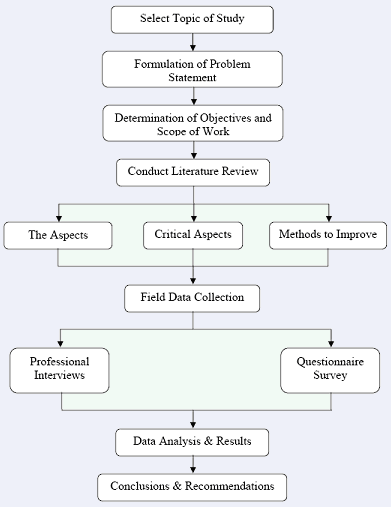
Primary and Secondary data
Miles & Huberman (1994) and Sekaran (2006) argued that primary data is easy to collect; however, the primary sources of law include authoritative records or statements of law (cases, statutes, regulations, or decisions) made by the legislative bodies. At the same time, documents like written opinions of courts, constitutions, legislation, rules of the court, and opinions of administrative bodies are also considered primary data; in addition, such sources pay special concentration to the legal authority to use in the legal systems; in addition, the researcher collected data from 100 participants using different tools of data collection.
On the other hand, Zikmund (2006) and Yin (2003) stated that secondary data is a more dependable source; so, this paper used several secondary sources including books, journal articles, and government publications; such as,
Process of Data Collection
To collect primary data from the Youth Offending Team managers and police officers, the researcher of this study has conducted interviews over the phone or distributed questionnaires by e-mail or other social networking sites, like Facebook and Twitter; in addition, the researcher will not consider the face-to-face interview as the questionnaire has not included any open-ended question. At the same time, the researcher has addressed many acts, orders, and other legal documents, for instance, Criminal Justice and Police Act – 2001, Crime and Disorder Act- 1998, Anti-social behavior order Act – 1999, Criminal Justice Act 1982, Children Act-1989, and Criminal Justice and Public Order Act-1994 have generated from the different government website.
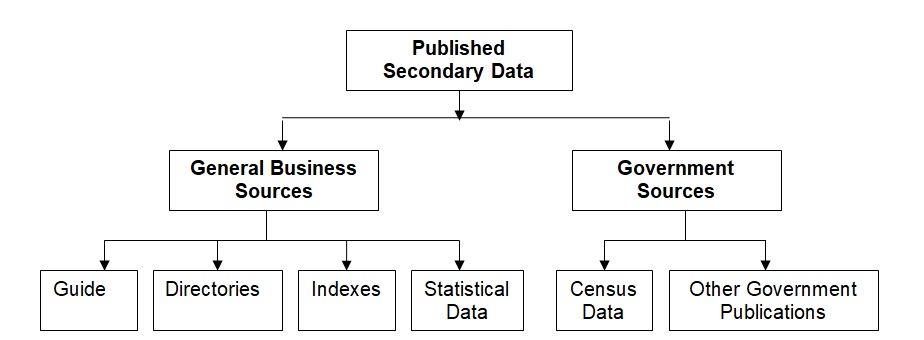
However, the following figure shows the data collection process –
Quantitative Research Approach
This dissertation will use quantitative research method, as Malhotra (2009) stated that the main aim of this approach is to quantify the gathered data; however, following figure explains the differences of two approaches –
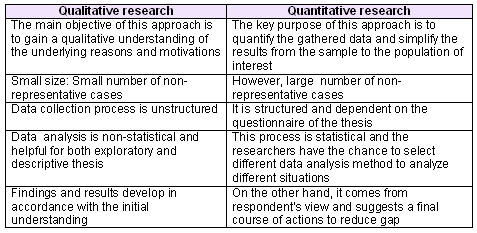
Questionnaire Design
This questionnaire has been developed for evaluation of key success factors to reducing youth antisocial behavior through legislative programs in Britain with a five-point Likert scale in order to suitable data collection from the respondents, the questionnaire has divided into four parts depending on the critical success factors those may contribute to diminish the youth ASB in the country.
Sample Size
The respondent groups consist of managers from different agencies, ASB coordinators, police officers, housing officers, and YOT13 managers that organized a sample size of 30 along with a further 20 from the youth offenders. The questionnaire has sent to the 150 respondents by e-mail to get feedback from the interviewees, but few respondents provided incomplete from, which was rejected at the time of data analysis; however, the response rate was 66.66% and the following table gives more information about the target groups –
Table 1: Selected Respondents in order to interview.
Data Analysis process
There are some unexpected errors in the quantitative data. In order to answer the key research questions, we should eliminate such errors. In addition, the data will be analyzed using Microsoft Excel and addressed through the generation of pie charts and bar graphs. I propose to use the primary data collected from target respondents to generate all the figures, pie charts, and bar graphs of chapter four. Such bars and graphs will explain the opinion of the people about reducing youth antisocial behavior through legislative programs in the UK. In this case, the figures will be original and self-generated.
Ethics
Some writers have already researched this field and contributed to the development of a legal framework related to antisocial behavior; however, the researcher of this present research has taken information from the previous research to explore and support research questions. However, the ethical considerations to using secondary data sources were the proper representation of the information from previous works with using appropriate referencing style, and justification to use such data to analyze the topic “reducing youth antisocial behavior through legislative programs in the UK”. On the other hand, a significant part of this dissertation is based on the primary data for which the obligation of the researcher was to find out the proper procedure to carry on the data collection process or integrate data in the main dissertation by focusing on moral standards. However, the topic related to the reduction of youth antisocial behavior is a sensitive area of research; therefore, the researcher had taken the consent of the respondents prior to conducting an interview or distributing the questionnaire and pursued the provisions of the data protection act 1998 as part of the privacy policy and ethical concern.
Ethics Statement
- Researcher of this dissertation had not interviewed mentally disabled person
- The research involves human participants and the age of target respondents was 18 or above;
- This dissertation fully complied with the rules and regulation to protect both primary and secondary data
Limitations of the study
During the research with reducing youth antisocial behavior through legislative programs in the UK, the researcher faced difficulties with several aspects, such as –
- Time constrain was one of the main problems to consider large sample size or target respondents because primary data collection is a time-consuming tasks;
- A large part of the respondents have not provided their feedback on time for which many completed forms have not evaluated for the research;
- At the same time, many research articles available in the secondary data sources and some of those articles include irrelevant or incorrect information;
- Limited budget created problem to conduct face to face interview
Findings and Results
Section A: Introductory questions
This section identifies the respondents with some formal details such as name, age, job position, gender, contact details, etc. It is important to keep such details in the record for further verification, just in case of any challenge with the findings of this research. However, keeping in line with the data protection act of 1998, the personal information of the respondents remains secret. Among the respondents, there were 60% males and 40% females, with 50% from school education, 16% from a college education, 10% from University with Undergraduate course, and 6% from graduate degree holders. A very nominal percentage (4%) was without any formal education. The following two graphs depict this data:
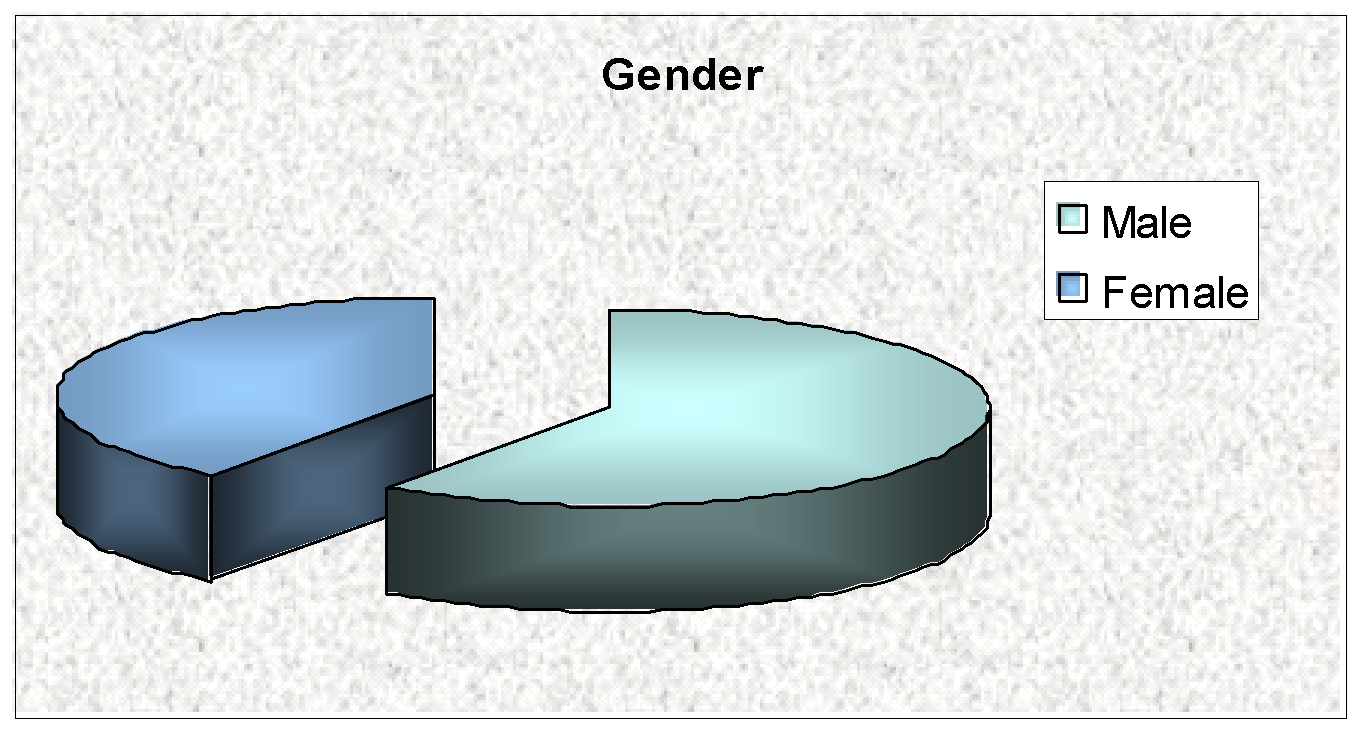
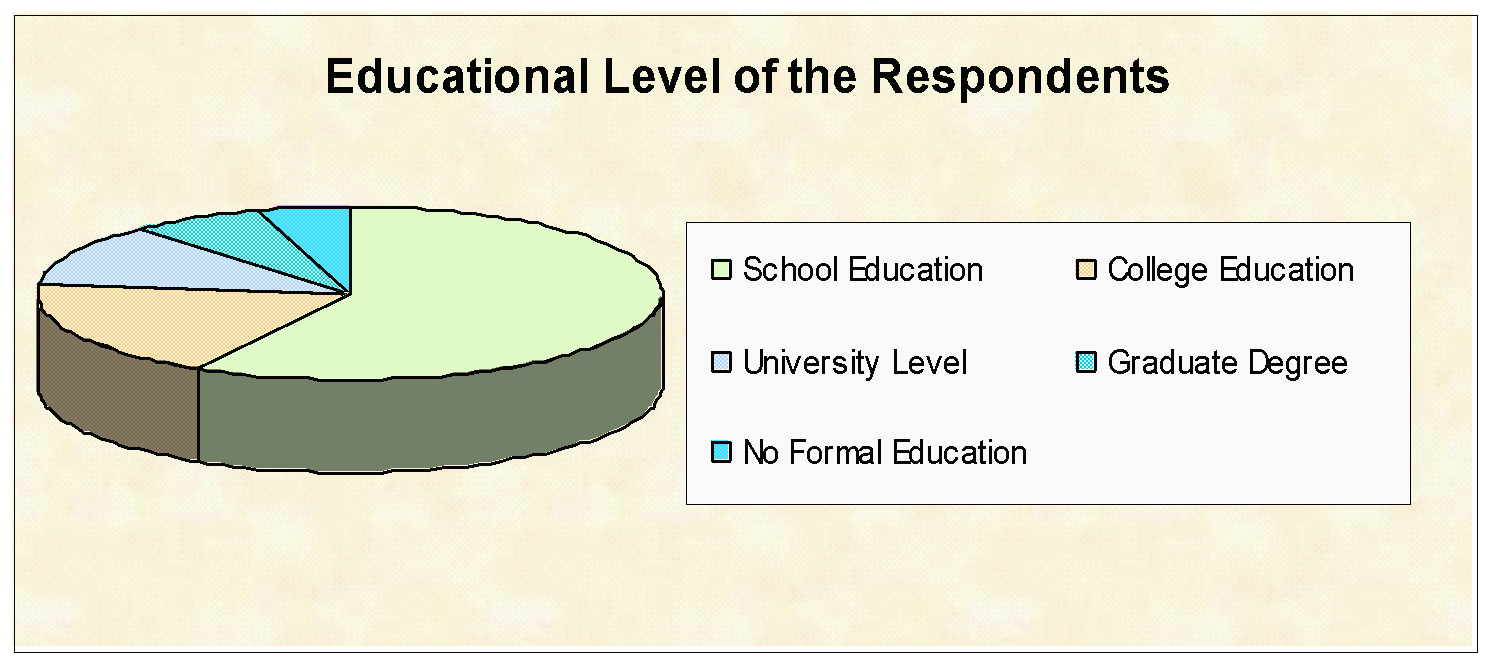
Section B: Survey Questions
Have you ever committed any ASBO’s offense?
Comments: The responses to this question illustrate that almost 78% of people, during their youth, have the general propensity to engage with antisocial behavioral practice. However, this common tendency of young people may not illustrate that they a have serious tendency to the criminal offense. In addition, modern psychologists explain it as a common phenomenon of the youth to make fun and enjoyment, without any intention of harming anyone. Moreover, fun and enjoyment are crucial for a child’s growth as these two things motivate a child to excel (Hemmings 2007). It would be a serious mistake to consider such a trend as criminal offense and send them for trial. Following is a graphical representation of the responses for this question:

Would you consider that the civil proceedings under ASBOs have imposed conviction for youth?
Comments: In accordance with the response of this question, overall 47% of people’s perception is that the ASBOs are not civil proceedings but a criminal conviction designed for young people. However, ASBOs are not always criminal actions. In fact, they take the shape of criminal sanctions when the offenders break the terms of ASBO (Crystal 2012). In contrast, other 47% of the respondents think that ASBOs included appropriate measures for young people to motivate them. The remaining 6% of respondents provided no comment. This means that ASBOs failed to generate the confidence in at least 47% of people. For any program, aimed at the welfare of society, it is necessary that it should have the consent of a majority of the people. However, the responses to this question suggest that the people are not convinced with the way ASBOs are operating. Following is a graphical representation of the responses for this question:
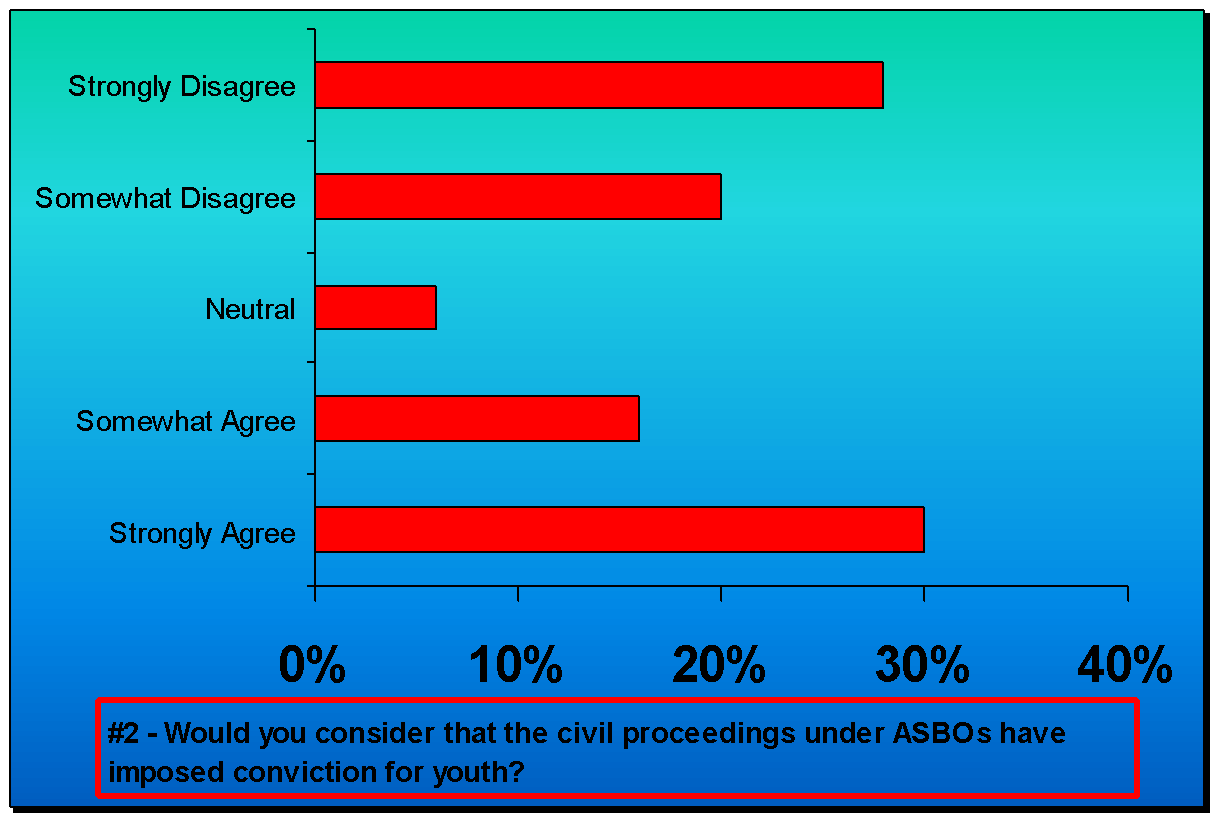
Do you think that the measures for anti-social behavior under the British legislative program have intended to rectify the young generation?
Comments: Among the respondents, 36% were of the opinion that the design of the ASBOs aims at rectifying antisocial behavior. ASBOs came into being in order to restrict a person from doing unruly or anti-social acts that might harm others in society. An important point here is that ASBOs apply to those who are persistent in doing anti-social activities, or in other words, for those who have a habit of doing anti-social activities (Durham 2013). On the contrary, 60% of respondents believed that the main aim of the ASBOs is not to rectify the antisocial behavior of the youth. According to them, rather than rectification or motivation, the new legislative framework has aimed to punish the youth, as a way to reduce antisocial behavior. The ASBOs just want to brush off their responsibility by forcing the youth to face trial. They do not have any social concern; in fact, they just want to save their faces. So, instead of rectifying the young generation, the stern actions taken by the ASBOs have made the youth rigid and stubborn. The policymakers propose to adopt different types of punishment to reduce antisocial behavior. However, they forget that punishment cannot be the remedy to rectify the anti-social behavior of the young generation. The young generation involved in criminal actions or anti-social behavior needs to tackling in a different manner, may be emotionally. However, the fact remains that there are people who believe that people still believe that punishment could be a good tool to motivate the young generation to abstain from anti-social behavior. Following is a graphical representation of the responses for this question:

Does the role of the Youth Justice Board (YJB) indicate youth as future leaders?
Comments: This question was necessary to be included in this survey because the Youth Justice Board (YJB) is a very important organization, aimed at protecting the future of the young generation. The YJB also provides “central leadership” for the youth so that the “youth justice outcomes” may have a continuous improvement (YJB 2012). Only 40% of the respondents believe in the efficiency of the YJB. According to them, YJB considers youth as future leaders and wants to inculcate leadership qualities in them. Being a state agency, the outlook of YJB would influence the overall youth antisocial behavior reduction program. In contrast to the respondents who agreed with the ideology of the YJB, 58% of the respondents disagreed and were opposed to the idea of the YJB being helpful. These people believed that the YJB does not indicate youth as future leaders. On the contrary, it treats the youth as a burden on the national economy. Following is a graphical representation of the responses for this question:
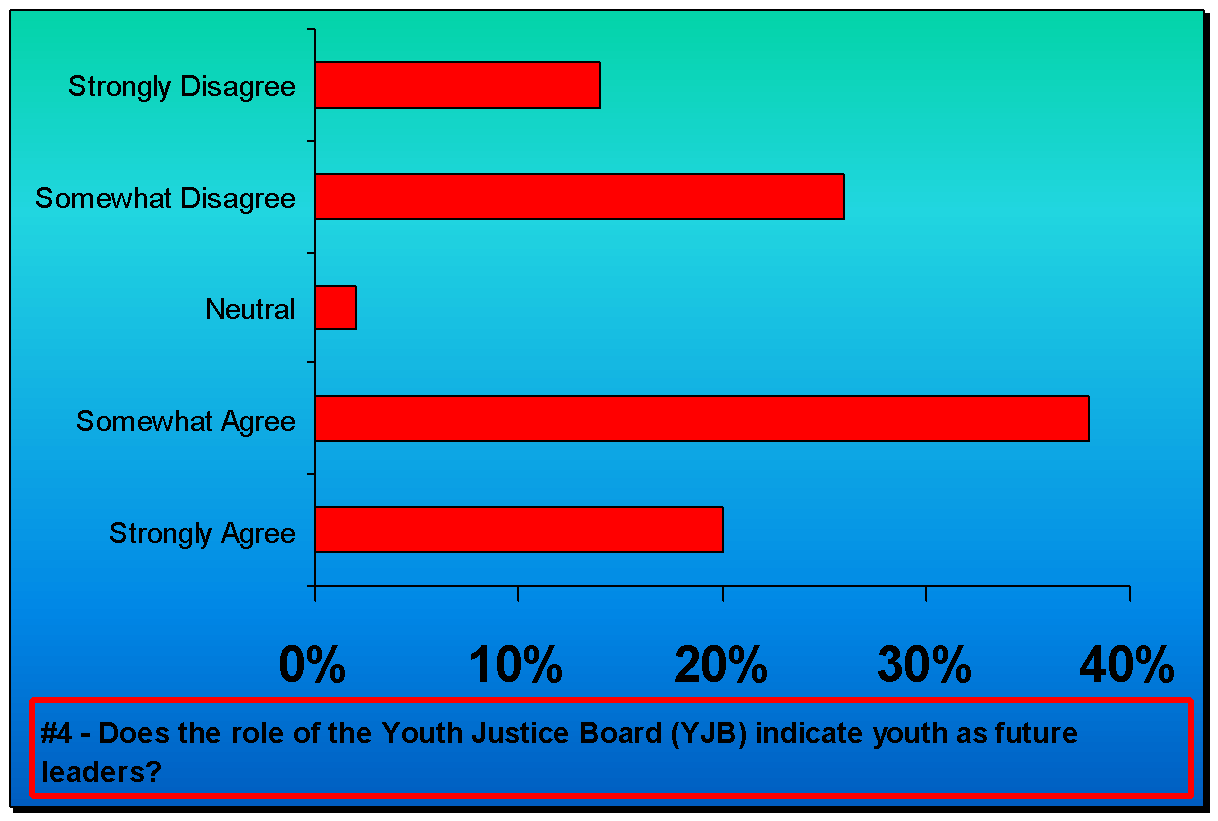
Do you think that ASBOs have breached human rights of the young people?
Comments: During the years, ‘Human rights’ is a term that has become very important throughout the world. Governments of various nations are taking steps to curb this menace. Even the United Nations is concerned and as a result, the International Court of Justice came into existence. In such circumstances, how can we accept inhuman activities being committed around us? The ASBOs are not the target of this statement. Rather, I am trying to bring out the emotions of people who responded in the affirmative (48%) to this question. These people believe that the ASBOs are continuously breaching the human rights of the young people and urged for immediate interference by the human rights activists. By breaching the human rights, the ASBOs, instead of providing help to the youth, are doing atrocities on them. Such people also believe that the behavior of the police (linked with ASBOs) is not at all acceptable. They take for granted that the youth generation is full of criminals. Some scholars are of the opinion that according to the ASB management, the young generation is a threat to the national development (Squires 2008 p. 226). The behavior meted out to the young generation seems to be a criminal treatment. Such outlook of the police and other local agencies would certainly have a negative impact on the overall youth antisocial behavior reduction program. Following is a graphical representation of the responses for this question:
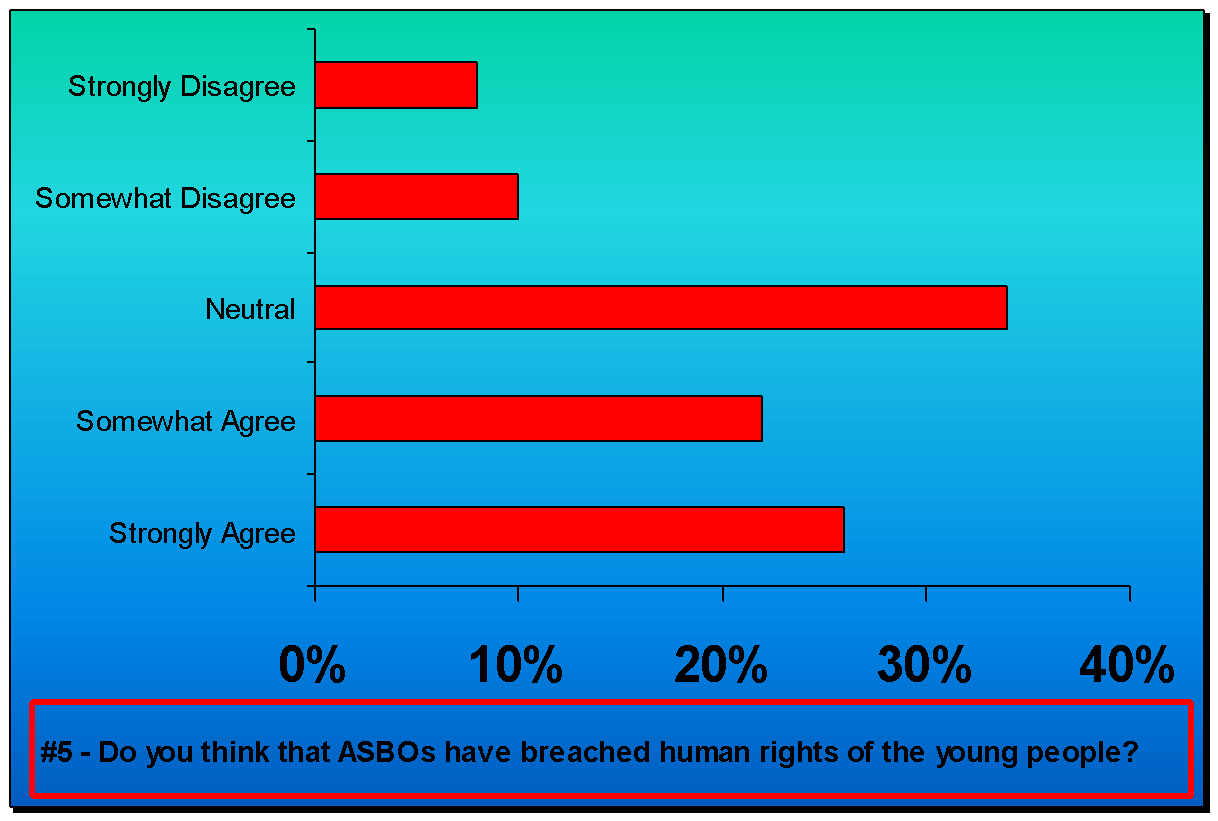
Do you think that the youth should help the female and older people by offering them their seats in buses and/or at public place?
Comments: This question has been included to categorise the youth ethical standards by assessing the degree of social obligation and the prevailing norms pertaining to being loyal to women and older citizens. “Human beings are social animals”. We have some social etiquette to follow. If all of us bring such etiquette into practice, there will total harmony throughout the world. One of the main points that such etiquette teach us is that we should always respect women and our elders. By doing so, we feel happy and content within our hearts (Shrigley 2007).It applies to the young generation as well. If their hearts are happy, they will never think of committing any anti-social activities. About 60% people agreed that the young generation of the UK is very sensible and respects females and older people. As the depth of such virtues is good enough, it is obvious that the young generation will be helpful in reducing antisocial behavior in the society. Following is a graphical representation of the responses for this question:
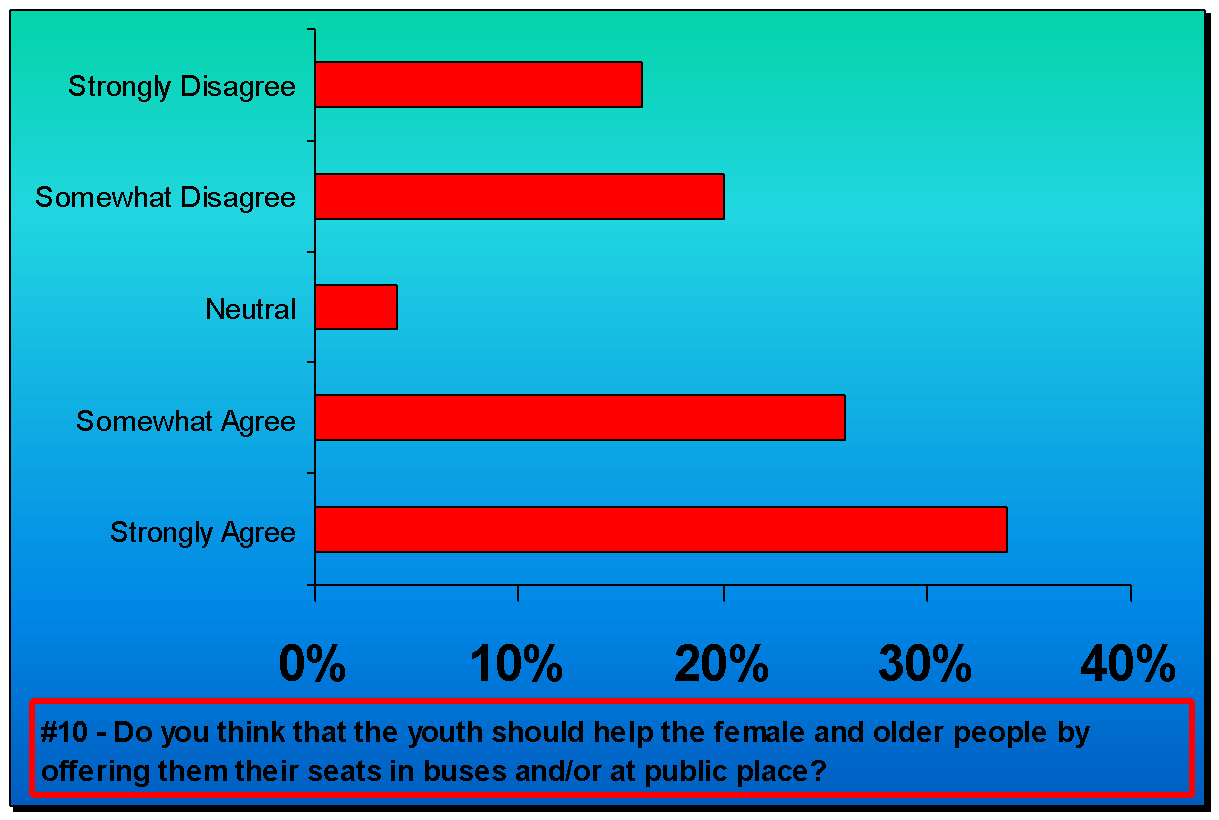
Question about Social Factors
This section raised the questions with the social factors those influence to reducing antisocial behavior through legislative programs those are concentrating on the behavior, lifestyle of the youth, and necessary statutory education to analysing the socio-economic factors.
Do you think that adult antagonism develops a sense of powerlessness among the youth?
Comments: This question determines the severity of antagonism prevailing in the society. It is astonishing to note that 72% people think that the negative attitude of older people towards young makes the young generation frustrated. It is not that the behavior of all the older people towards the young generation is the same. Nevertheless, as “a bad fish spoils the whole tank”, antagonised behavior of a couple of older people towards the young generation sends wrong messages. As a result, most of the young people think that their elders are out there to abuse and control them. This attitude of the elders demotivates the younger generation (Bursack 2009). Moreover, they have already started to think themselves powerless and hopeless. The younger generation is the backbone of a nation’s future progress. Such demotivation of the young is not at all good for the future prospects of the nation as well as the young generation. Following is a graphical representation of the responses for this question:
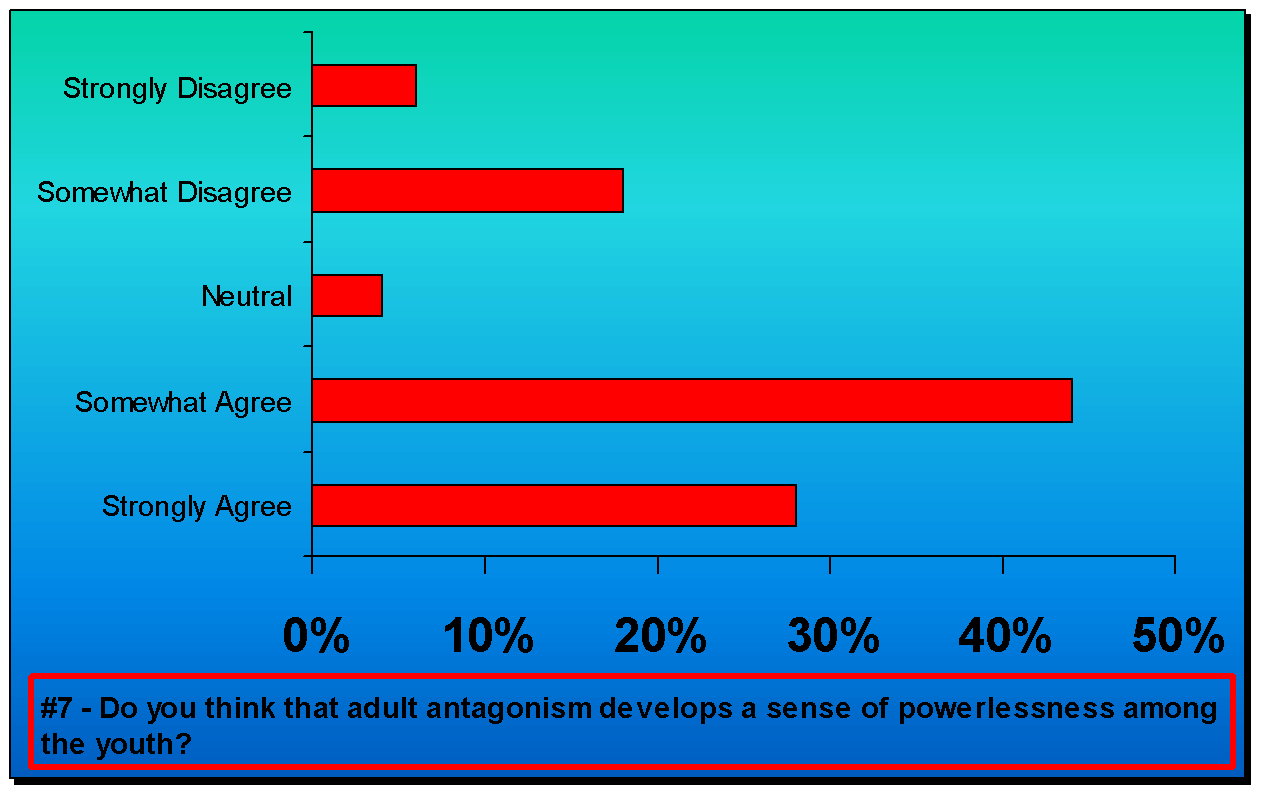
Do the adults, older citizens, and teachers play a significant role in reducing antisocial behavior by developing a positive approach in the children?
Comments: This question tries to identify the possibility of getting cooperation from the adults, older citizens, and teachers in removing the antisocial behavior of the young people. The adults, older citizens, and teachers of the society provide a role model of social behavior to the young people. By following such models, the common tendency of the young people, to align with the trend of serious criminal offenses, may reduce (Home Office 2003). Almost 64% of the respondents believe that the goodwill of the adults, older citizens, and teachers of society has the capability to change the behavior of the children. Modern psychologists explain that if the young generation gets inspiration from friends and family, they could grow up with high morals and values.
Teachers of primary schools have the capability to develop positive attributes among children that would reduce the trend of juvenile delinquency from childhood. The Primary schools could play significant role in reducing antisocial behavior by developing positive approach among the children. Following is a graphical representation of the responses for this question:

Question about the Role of Parents
The main objective of this chapter is to determine the role of friends and family in reducing antisocial behavior. In case of any misfortune to the youth, their family might have severe negative impacts. Therefore, the family members ensure that they treat the kids with extra care, thence making the family’s role very significant in developing good virtues among the children.
Do you agree that emotional connection between parents and children could reduce antisocial behavior?
Comments: The aim of this question is to identify the outcome of parental integration in reducing antisocial behavior. It is the opinion of 78% of the respondents that emotional integration of children with their parents could reduce antisocial behavior. Thus, the parents should change their schedule to give more time to their children at home and interact with them. Parents are means of structuring their child’s future. They have a very crucial role to play in their child’s growth and his/her conduct. Deep parental supervision and family discipline could generate high ethical standard among the youth. Parents should consider spending time with their children while designing their work plan. Parents should also ensure that they do not show any arrogance while interacting with their children (Mackay 2005). Negative behavioral problems like arrogance and rude attitudes come from the lack of family care and parental negative attitudes. Therefore, parents should be more careful in this regard. Another important aspect (related to the family) that could have a deep impact on the children is the family background. Family’s criminal record has serious impact on the antisocial behavior of youths, thus children from a family with a criminal record tend to take the same track, and hence they need additional care. Both parents and the school have to work in mutual co-operation to enhance the educational experience of a child and to mould his/her career. In fact, schools encourage parents to be more involved in their children’s activities because the school authorities know that parents’ involvement can bring about great positive changes in the students. That’s the reason schools invite parents to attend various school activities and functions. Following is a graphical representation of the responses for this question:
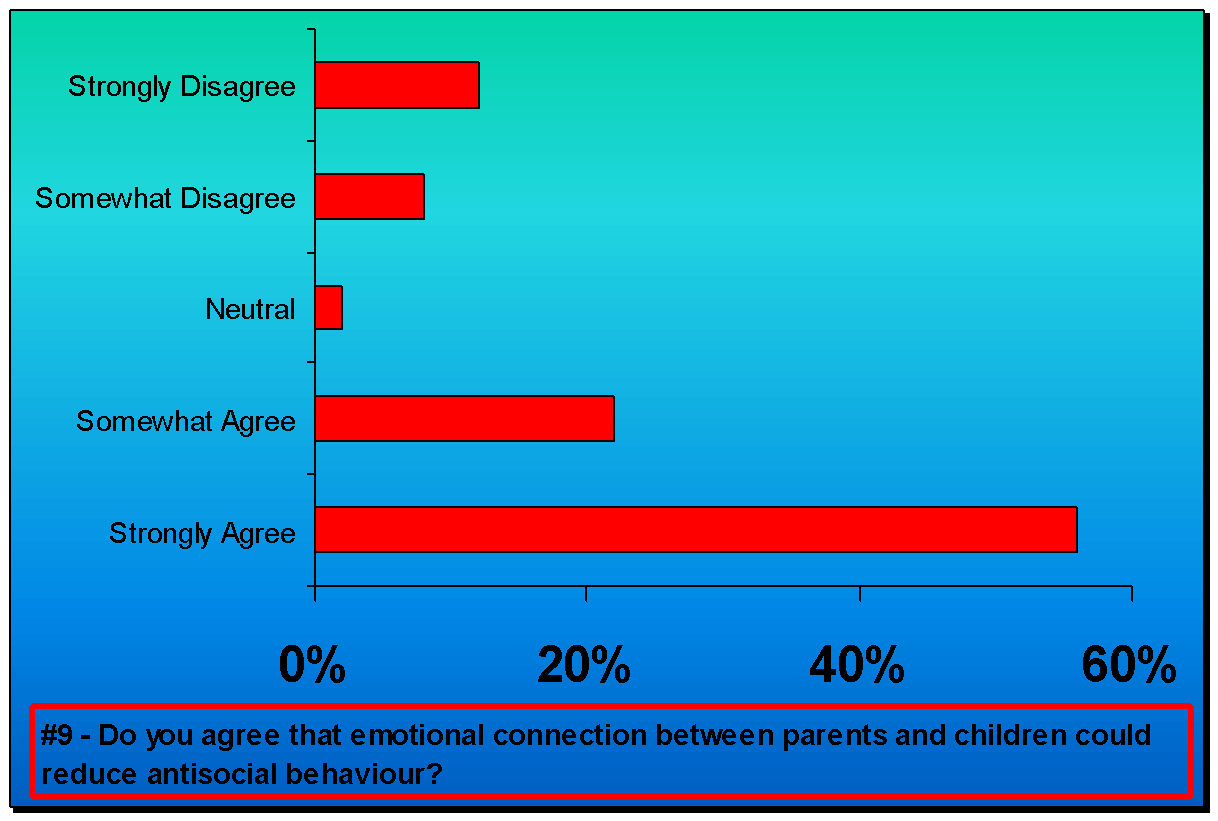
Question about Economic Factors
This section of the survey has been organised to assess the economic factors that may have greater influence on reducing the antisocial behavior of young people.
Does the lower income level and poor housing lead the youth to engage in antisocial behavior?
Comment: The aim of this question is to identify the impact of poverty on the antisocial behaviors of the youth. Poverty is a dilemma that the society has been facing since time immemorial. The rich are getting richer and the poor are getting poorer. This obviously creates some sort of disparity between the rich and poor. The poor are disgruntled and as a result, engage in anti-social activities in order to divert their minds from poverty. There is another reason for children, from poor family background, engaging in anti-social behavior. They want to show that even though they are not rich, they are ahead in something. Probably, being anti-social is the only thing that they can think of, without having to spend anything. Poor housing is also one of the major factors that provoke the children to do anti-social activities (Calhoun et al 2001). There have also been instances where poor parents treat their children as an extra burden. The children feel neglected and turn to being anti-social. This creates problems in the society. All these are the reasons pertaining to children being anti-social when their families are poor and qualify for being the ground level reasons of increasing antisocial behavior and social unrest. Following is a graphical representation of the responses for this question:
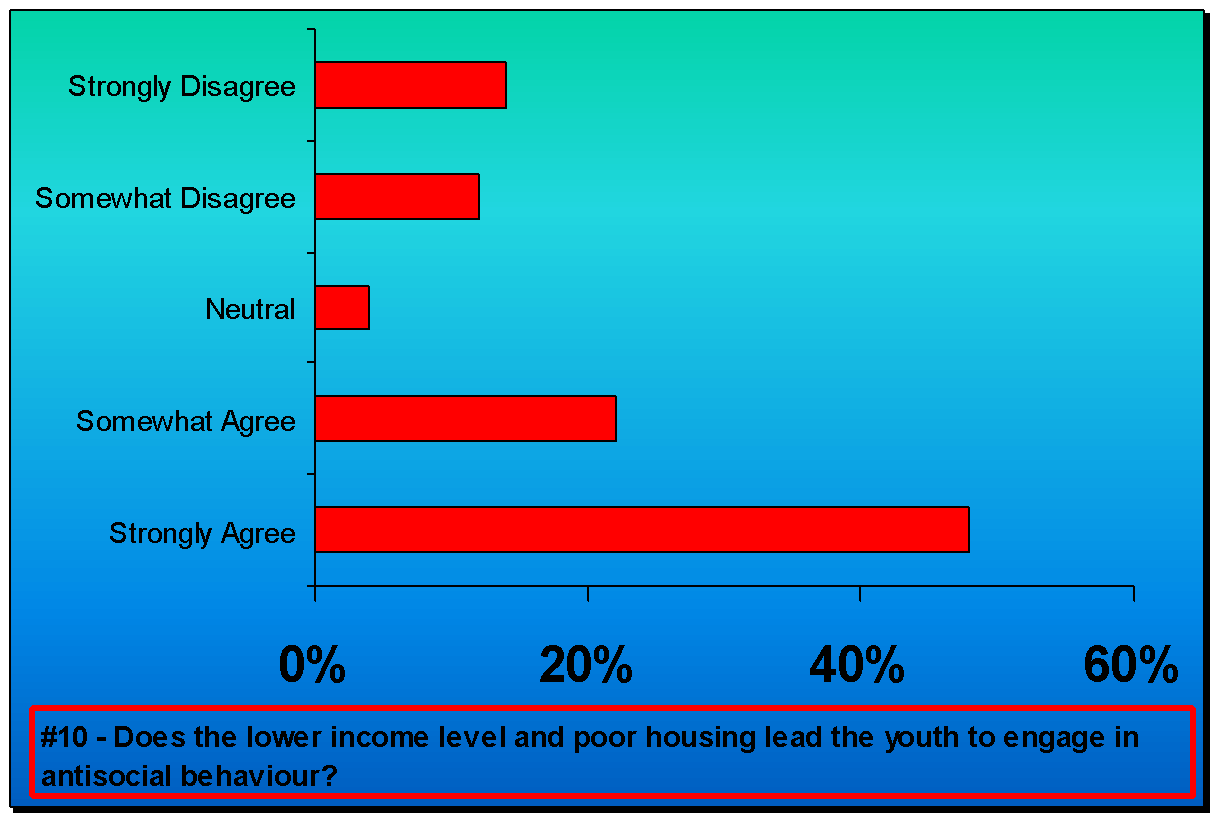
Discussion
Sentencing Guidelines for ASBOs Violation
SGC (2008) pointed out that the guiding principles for sentencing breach of ASBOs, obviously, the court will consider the best of welfare for the children and youth by keeping keen attention to the internationally prevailed conventions and treaties relating to the juveniles; in addition, the aim of the sentence is to prevent re-offending by improving problematic behavior. The guiding principles also urged to align with restorative justice that is a significant privilege allowed for the young people through referral, reparation, and supervision orders, for the first instance and less serious ASBO violation by the children and youth the court would consider for an absolute discharge, hospital or referral order, which is appropriate under court’s discretion. However, the court could impose community sentence, detention, training order, and fine structured up to £250 for the juvenile delinquent aged 10 to 14 years, and penalties of £1,000 for the juvenile delinquent aged 15 to 17 years while the adults for similar offense would penalised £5,000 or 5 years imprisonment or both (SGC 2008).
The section 147(2) of the CJA-200314 kept provision for sentencing five youth community orders for the violation of ASBO mentioned as below, the court has the discretion to impose any one of them or all where it applicable –
- The Curfew Order: – this provision was introduced to keep the offender at a particular area for certain time (minimum 3 to 6 months); for the juvenile delinquents aged under 16
- The Exclusion Order: – This order is sanctioned to prohibit the juvenile delinquents aged under 16 from entering at a particular area for a maximum of 3 months
- The Attendance Centre Order: – It has designed to ensure the attendance of the offender at a selected centre for an aggregate maximum 24 hours for the juvenile delinquents aged under 16;
- The Action Plan Order: – Under this order, the offender would send for supervision for an intensive period (minimum 3 months) independently adapted the various requirements;
- The Supervision Order: – This order could be imposed the broader assortment of requirements that last for up to 3 years while it also includes the ISSP15 that designed with most careful non-custodial interference sanctioned to the juvenile delinquents; however, the court has discretion to order for short DTO16,.
On the other hand, in case of youth offenders of 16 to 17 years, the court has discretion to impose community rehabilitation order that designed with an ISSP17, or CPO18, or CRPO19 (courts can consider any one or all together for 6 months to 3 years); however, the offender has to perform unpaid community work for 40 to 240 hours. There are also provisions for custodial sentence for the youth antisocial behavior by sanctioning DTO that provides minimum 4 to maximum 24 months detention and training for the youth offenders aged 15 to 17 years, to impose DTO for delinquents aged 12 to 14 years required to prove ‘persistent offender’ while age group 10 to 11 have no custodial sentence.
Britain’s Progress to Reducing Antisocial behavior
House of Commons (2013) pointed out that the statistics of police illustrated that there were 2.4 million events (those violated ASBO) have recorded in the police stations of England and Wales during September 2012 while the Housing-providers handle around 300,000 cases per annum, not all of them were sent for trial, a maximum of them settled out of the court. Among the cases went for trial from the second quarter of 1999 to the end of 2011, there were 21,749 ASBOs issued by the courts in different sentences among them 85% offenders were male (young and adult) whereas only 15% were females. However, about 57.3% of the youth offenders violated ASBO for at least once of their lifecycle while 42.7% of the delinquents breached ASBO for several times (violated ASBO 4.7 times on average) with similar offense; thus, repeated occurrence of similar offense indicates criminal trend of the youth. If an ASBO is breached, it is breached an average of 4.7 times (The Commentator 2012).
It is also evident that 38% of the ASBO issued against juvenile delinquents aged from 10 to 17 years while this age group is only 13% of the entire population of the UK, at the same time, the ASBO violation rate among the youth and adult are 52% and 42% respectively. The Ministry of Justice (2012) explored the anti-social behavior statistics that illustrated the number of ASBOs issued in 2005 were 2,204 and from that year the violation of anti-social behavior order in Britain has reduced at a rate of 13.5% per year that resulted the breach of ASBO in 2010 at a figure of 1,052 cases.
Age of Criminal Responsibility Bill 2012-13
House of Lords (2013) mentioned that the Age of Criminal Responsibility Bill 2012-13 has introduced by Lord Dholakia, and completed the first reading on 16th January 2013 and ordered for printing to distribute for second reading, which is an ongoing stage, later it will send to another committee at report stage and post to HC20 in third reading stage. From House of Lords, it would go for scrutinizing by the House of Commons for consideration, amendment and execution after having he royal consent for the provision to raise the age of criminal responsibility from ten (10) to twelve (12), pointed in the section 50 under the CYPA 193321. As the Age of Criminal Responsibility Bill is under ongoing process and takes time to come into force, there is no considerable impact in the society of England and Wales; but it is essential to take into account of the background for which the House of Lords kept their significant effort for this bill.
Conclusion & Recommendation
Conclusion
This research collected respondents’ view to identify the critical factors that can reduce the youth antisocial behavior, such as, why the juvenile delinquency has been decreasing in the modern British society, why the increasing numbers of youths are involving themselves with criminal offense; however, this paper pointed out both the risk factors and protective factors to meet research objectives. Depending on the present legislative framework for youth antisocial behavior, this paper predicted the subsequent attachment of the youth with increasing crime while the protecting factors that safeguard the children, as well as young people, are far away from the risks that they put into practice. Concurrent legal program to encounter with the increasing youth antisocial behavior, this research recognised the coordination between the risk and protective issues those have prevailed in England and Wales at their national level; however, by scrutinising the successful legal or regulatory schemes, the study concluded that it is simultaneously reducing the risk factors as well as promoting the protective factors. Under the same legislative framework, some children are loyal, grownup with moral dignity and excellence of good manners; while most of the children are mature with antisocial behavior, arrogant and rude attitude to involve with criminal offense to carry out a complete assessment of risk; thus, the legislative programs aimed to prevent offending. The other risk factors of the juvenile offending along with substance abuse extend beyond exceptionally big degree of local regions along with the academic accomplishment, young paternity, and teenager mental health crisis along with other psychological factors that may treat the youths to take action to prevent the risk factors those assist to resist the variety of negative effects.
Recommendation
- This research has already organised a solid base of pragmatic verification for ‘which items’ are dropping the risk factors as well as which approaches are developing the safeguarding factors, the exacting affiliation of risk factors and analytical factors identified to boost both the knowledge base and understanding the youth crime preclusion, which may be the prospective area for further research.
- The research has identified that the different youth groups are surprisingly inclined by diverse risk and defending aspects, for instance, promoting the protecting factors for young female offenders are totally different from the youth male offenders or poles apart from the minority ethnic groups; thus, the research conducted with a single group must be different with other group. Consequently, this dissertation recommends that any further research with the youth antisocial behavior should focus on a single ethnic group without amalgamating more than one or several ethical alignments;
- The major problem of research with the juvenile delinquency or youth antisocial behavior are lack of people’s involvement and small numbers of respondents, and little contribution of available secondary data sources to progress of youth and children; therefore, it is essential to target large groups of respondents to interview to analyse the actual situation of society in this regard.
- The antagonistic relationship between the youth and adult, the technological progress within the last decade, and youth’s early introduction with the modern technology has placed youth face to face with the policymakers. Policymakers and legislators are the representative of adults. Ironically, they pay less attention or intentionally ignore the youth psychology during policy formation. Thus, youth antisocial behavior is now a rising political agenda of the society of modern Britain who are eager to establish a harmonised youth strategy for the nation without any irrevocable antagonism and a more progressive outlook that the youths of today are the future leaders of tomorrow.
- Parents to act as motivating agents: Usually, parents tell bedtime stories to their children. These stories have a great influence the way a child thinks and are instrumental to quite some extent in moulding his/her behavior and conduct. Therefore, parents should tell such stories that have some moral values. The child will get inspired from them and behave accordingly. Stories of heroes and successful people will encourage the child to be like one of them. Parents can also motivate their children by doing good acts themselves. This way, children will not even have the idea of anti-social activities.
- Education level of parents has an impact on the children as well. If the parents are well educated, they ought to understand the importance of education and will encourage their child to study better and up to high levels. Uneducated or less educated parents will not be able to understand the importance of moulding their child’s career from the early school days. On the contrary, well-educated parents will understand that for achieving success and objectives, the foundation of their child should be strong. Educated parents will be able to explain better, to their children, the ill effects of anti-social activities.
Reference List
Bell, R & Jones, G 2002, Youth Policies in the UK: A Chronological Map, Web.
Brogan, D 2005, Anti-Social behavior Orders: An assessment of current management information systems and the scale of Anti-Social behavior Order breaches resulting in custody, Web.
Brown, K 2011, Beyond ‘Badges of Honour’: young people’s perceptions of their anti-social behavior orders, Web.
Burney, E 2005, Making People Behave: Anti-social behavior, Politics and Policy, Willan Publishing, London.
Bursack, C 2009, Elders who Abuse the Relatives who are Taking Care of them, Web.
Calhoun, G, Glaser, B & Bartolomucci, C 2001, ‘The Juvenile Counselling and Assessment Model and Program: A Conceptualization and Intervention for Juvenile Delinquency’, Journal of Counselling & Development, vol. 79, no. 2, pp. 131-141.
Card, R & Ward, R 1998, The Crime and Disorder Act 1998: A Practitioner’s Guide, Jordan Publishing Ltd, Bristol.
CIVITAS: Youth Crime in England and Wales 2012, Web.
Cohen, L, Manion, L & Morrison, K 2007, Research Methods in Education – 6th edition, Routledge, New York.
Connell, C, Cook, E & Brex, R 2011, ‘Risk and Protective Factors Associated with Patterns of Antisocial behavior among Non metropolitan Adolescents’, Aggressive behavior, vol. 37 no. 1, pp. 98-106.
CPS: Anti-Social behavior Orders on Conviction 2012, Web.
Crawford, A 2009, Criminalizing Sociability through Anti-social behavior Legislation: Dispersal Powers, Young People and the Police, Web.
Crystal, G 2012, Anti social behavior orders, ASBOs: Your rights, Web.
Donoghue, J 2008, Antisocial behavior Orders (ASBO’s) in Britain: Contextualizing Risk and Reflexive Modernization, Jordan Publishing Ltd, Bristol.
Durham, J 2013, Applying for an anti-social behavior order, Web.
Ensor, R, Marks, A & Hughes, C 2010, ‘Trajectories of Antisocial behavior towards Siblings Predict Antisocial behavior Towards Peers’, Journal of Child Psychology & Psychiatry, vol. 51, no. 11, pp. 1208-1216.
Flint, J & Nixon, J 2006, Governing Neighbours: Anti-Social behavior Orders and new Forms of Regulating Conduct in the UK, Web.
Frick, P & White, S 2008, ‘Research Review: The Importance of Callous-Unemotional Traits for Developmental Models of Aggressive and Antisocial behavior’, Journal of Child Psychology & Psychiatry, vol. 49, no. 4, pp. 359-375.
Hallsworth, S 2010, Anti Social behavior: Rethinking Definitions and Principles, Web.
Hayden, C 2011, Crime, Anti-Social behavior and Schools in Britain – Are All Schools ‘At Risk’, Web.
Hemmings, P 2007, ‘Renegotiating the primary school: Children’s emotional geographies of sport, exercise and active play’, Children’s Geographies, vol. 5, pp. 353-371.
Hine, J & Williams, B 2007, DFES Youth Strategy Review, Web.
Home Office 2003, A Guide to Anti-social behavior Orders and Acceptable behavior Contracts, Home Office Communication Directorate, London.
Home Office 2003, Respect and Responsibility – Taking a Stand against Anti-social behavior, The Stationary Office Limited, UK.
House of Commons 2013, The draft Anti-social behavior Bill: pre-legislative scrutiny, Web.
House of Lords 2013, Age of Criminal Responsibility Bill [HL], Web.
Innes, M & Jones, V 2006, Neighbourhood Security and Urban Change: Risk, Resilience and Recovery, Web.
Jakobi, S. 2007, Early-years support for parents would reduce youth crime, Web.
Lister, S & Crawford, A 2007, The Use and Impact of Dispersal Orders: Sticking Plasters and Wake-Up Calls, Policy Press, Bristol.
Loeber, R 1990, ‘Development and Risk Factors of juvenile Antisocial behavior And Delinquency’, Clinical Psychology Review, vol. 10, pp. 1-41.
Mackay, R 2005, ‘The Impact of Family Structure and Family change on Child Outcomes: A Personal Reading of the Research Literature’, Social Policy Journal of New Zealand, vol. 24, pp. 111-133.
Mackenzie, S 2010, The drivers of perceptions of anti-social behavior, Web.
Mahoney, J, Stattin, H & Lord, H 2004, ‘Unstructured Youth Recreation Centre Participation and Antisocial behavior Development: Selection Influences and the Moderating role of Antisocial Peers’, International Journal of behavioral Development, vol. 28, no. 6, pp. 553-560.
Malhotra, N 2009, Marketing Research – An Applied Orientation – 5th edition, Prentice Hall, London.
McGuire, J 2011, The impact of Anti-Social behavior Orders upon youth custody rates, Web.
Miles, M & Huberman, M 1994, Qualitative Data Analysis, Beverly Hills, CA.
Millie, A 2009, Anti-Social behavior. Open University Press, Berkshire.
Prior, D & Paris, A 2005, Preventing Children’s Involvement in Crime and Anti-Social behavior: A literature Review, Web.
Ross, A, Duckworth, K & Smith, D 2010, Prevention and Reduction: A review of strategies for intervening early to prevent or reduce youth crime and anti-social behavior, Web.
Rutherford, A 1986, Growing out of Crime, Penguin, Harmondsworth.
Sadler, J 2008, Implementing the Youth ‘Anti-social behavior’ Agenda: Policing the Ashton Estate, Web.
Saunders, M, Thornhill, A & Lewis, P 2006, Research Methods for Business Students – 4th edition, FT Prentice Hall, London.
Sekaran, U 2006, Research Method for Business – 4th edition, John Wiley & Sons, London.
SGC: Breach of an Anti-Social behavior Order 2008, Web.
Sherman, L & Strang, H 2007, Restorative Justice: The evidence, The Smith Institute, London.
Shrigley, L 2007, The Importance of Respecting Elders, Web.
Solanki, A, Bateman, T & Hill, E 2006, Anti-Social behavior Orders, Youth Justice Board, London.
Solomon, E 2004, A Lost Generation: The experience of young people in prison, Prison Reform Trust, London.
Squires, P. 2008, ASBO Nation: The Criminalization of Nuisance, The Policy Press, Bristol, UK.
Squires, P & Stephen, D 2005, Rougher justice: Anti-social behavior and young people, Willan Publishing, Cullompton.
SSHD: Putting Victims First More Effective Responses to Anti-Social behavior 2012, Web.
Strickland, P 2012, Anti-social behavior – The Government’s Proposals, Web.
The Commentator 2012, Britain’s anti-social behavior orders breached over 50% of the time, Web.
The Ministry of Justice 2012, Statistical Notice: Anti-Social behavior Order (ASBO) Statistics England and Wales 2011, Web.
Ward, P & Woodhouse, J 2012, Designated Public Place Orders, Web.
Watson, L 2012, Family of Fiona Pilkington who killed herself and her daughter after years of abuse from yobs wins five-figure payout from police who failed to protect them, Web.
Williamson, H 2004, The Milltown Boys Revisited, Berg Publishing, Oxford.
Wisniewska, L, Harris, L & Oliver, C 2006, Respect: The Voice behind the Hood, YouthNet and the British Youth Council, London.
WYS: Facts and Stats: Youth crime in England and Wales 2011, Web.
Yin, R 2003, Case Study Research: Design and Methods – 3rd edition, Beverly Hills, CA.
YJB 2012, YJB corporate plan 2012-15 and business plan 2012/13, Web.
YJB: Quality Standards for the Youth Inclusion program 2005.
Young, J 1999, The Exclusive Society: Social Exclusion, Crime and Difference in Late Modernity, SAGE, London.
Zikmund, W 2006, Business Research Methods – 7th edition, Harcourt Publishers, Orlando.
Appendix 1
Questionnaire
Name: ___________________________
Age: _________
Address: _____________________________
Phone number: ____________________________
Company Name: _____________________________
Footnotes
- Anti-social behavior Orders.
- Youth Custody Centres.
- Youth Offender Panels.
- Youth Offending Teams.
- Anti-social behavior Act 2003.
- offenses Against the Persons Act 1861.
- Protection from Harassment Act 1997.
- Antisocial behavior.
- Anti-Social behavior Orders.
- Youth Justice Board.
- Office of the First Minister and deputy First Minister.
- Children and young people’s unit.
- Youth Offending Team.
- Criminal Justice Act 2003.
- Intensive Supervision and Surveillance program.
- Detention and Training Order.
- Intensive Supervision and Surveillance program.
- Community Punishment Order.
- Community Rehabilitation and Punishment Order.
- House of Commence.
- Children and Young Persons Act 1933.